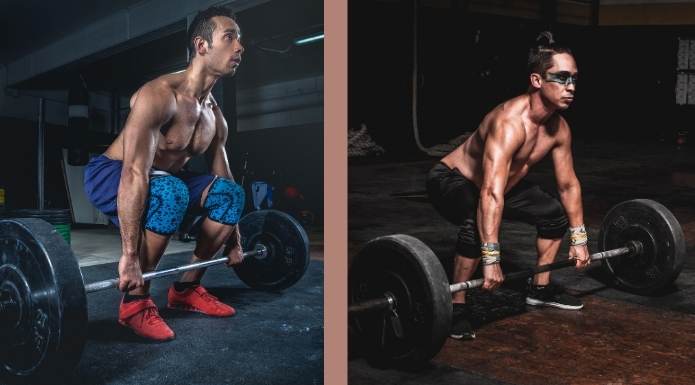Some say that you should drag the bar against your shins and over your knees when deadlifting. Is this true? Well, I have a secret way to find information. Not just any information, but wrong information. I just go the Stronglifts site. There, I can find an author with absolutely no idea what he is talking about and have a never-ending stream of wrong information to correct. This is how I came upon an idea about how to deadlift and lower back pain.

Should you deadlift with the bar close to your legs? Yes, of course. But, according to Stronglifts, you must not only start with the bar close to your shins you must drag the bar up your shins and thighs.
Arm yourself against fitness and nutrition Bullshit in ways you never thought possible. Read The BS Vaccine for Fitness and Nutrition, my free online book.
It is hard enough to lift the bar straight up, let alone drag it backward and up at the same time. For most of us (there may be exceptions due to body proportions), if we are actually dragging the bar against our legs as we lift, we are pulling the bar back not just up. This is not what I’d call economy of motion.
Here is what Strong(weak)Lifts says, paraphrasing:
“The further away from your body the bar is, the heavier it feels.”
Well, that is true. Here’s why.
“The front raise is harder than the overhead press.”
Ummm…what? (Just thought I’d throw this in. Some people have a strange definition of hard. It’s harder to lift a heavy weight in a front raise, of course, but you don’t generally lift heavy weights that way. On the other hand, the overhead press is a bit more technical than a front raise.
“If you deadlift with the bar drifting away from your legs it is harder on your lower back…Drag the bar over your shins, knees, and thighs to the top.”
So, I am supposed to not only have to deal with the weight of the bar, I am supposed to intentionally create friction, pull the bar in the wrong direction (back instead of up), and even have to navigate it over my bony knees? And…
“You must do this to save your lower back…”
Really? Because when I pull back on the bar, a funny thing happens. It becomes more about my lower back than when I pull straight up on the bar. The idea that if you don’t drag the bar along your legs you will injure your lower back is unbacked by any evidence, whatsoever. But wait:
“If you have bloody shins, the bar is too close…”
Now, this is confusing. You want me to not have the bar too close but you want me to drag it over my shins. Without getting bloody shins.
No post found
Proper Deadlift Bar Path
Ridicule done. The proper bar path for the deadlift, is UP. Not back and up, just up. If you start with the bar over your midfoot or so, and place your shoulders in front of the bar, and pull straight up, it will drift outwards just a bit just below the knee level or so. This is a mechanically awkward phase of the lift. But this will not automatically injure your lower back! The solution to overcoming a mechanically disadvantaged part of a lift is not to make it more disadvantaged. The solution is to learn to maintain force output throughout the lift. Keep pulling.
So, where did this guy get these ideas? Well, he probably got them from bodybuilding forums and the like, and very large heavyweight powerlifters, some of which do tend to drag the bar back. The usual instruction is something like “sit back and pull on the bar” or “lean forward and then roll back and pull.” An example of a powerlifter who instructs this is another Mississippi boy like myself, Richard Hawthorne.
Benedikt Magnússon also uses the ‘roll the bar back and then pull’ technique:
Eddie Hall does this, too. However, some of these lifters have a weight advantage over us mere mortals. Pulling back, for a heavy enough fellow, means sheer bodyweight can be applied to the bar. Is it efficient? No. Does everyone who is a heavyweight do it? NO!
Am I saying it is dead wrong for any lifter to ever drag the bar up the legs? No. I do not think it is a good method for most lifters, but there are some successful lifters who practice this and advocate it. But the very reason given for dragging the bar up the shins, keeping the bar close the body, is defeated when you have the bar too close and have to move it around your knees. The bar gets kicked out in front of you!
It’s the Distance Of The Hips, Not the Shins
On the other hand, if you start with the bar at mid-foot, move the shoulders forward of the bar, and then endeavor to pull the bar straight up, you are actually keeping the bar on a better path, closer to your body. The trick in deadlifting is to not how close the bar is to your shins, but how close it is to your hips, which are the fulcrum. The further the bar away from the fulcrum, meaning the “lever arm” your body, is lengthened, the more brute force needed to move it.
But, there must be a reason for this instruction, in general. One source is mistaking appearance with intentions. Great lifters, especially lanky ones, will often bruise or bloody their shins. This leads many to think that they are intentionally dragging the bar on the shins. Some lifters who have no intention of dragging the bar will inadvertently appear to be doing just that. This doesn’t mean they actually advocate it or intend to do it. Those lifters who adopt a lower hip position will find the knees getting in the way and if they try to pull the bar straight up this will also make it appear as if they want to drag the bar around their knees.
No post found
Here is a very detailed instruction by Pete Rubbish on how he deadlifts. He states explicitly that he does not want to drag the bar on his shin and actually mentions what I did above, that the bar gets kicked out. He is an extremely strong deadlifter and I cannot argue with his results or his intelligent explanation.
But since he adopts a lower hip position than I would think necessary, the bar tends to track around his knees. Without the verbal instruction, superficial observation (beware of observer bias!) could lead you to believe that he is purposely tracking the bar on his legs. However, his intention is to pull the bar up. Of course, as he mentions, you don’t want to start with the bar too far away either, or your first movement will be pulling the bar back, not up.
No post found


